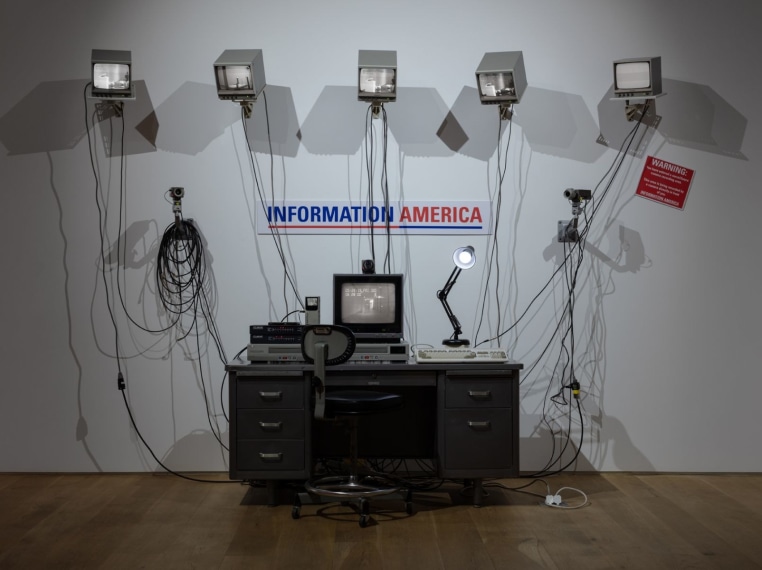
Photo: Timothy Doyon, Courtesy of Ortuzar Projects
Photo: Timothy Doyon, Courtesy of Ortuzar Projects
Photo: Timothy Doyon, Courtesy of Ortuzar Projects
Photo: Timothy Doyon, Courtesy of Ortuzar Projects
Photo: Timothy Doyon, Courtesy of Ortuzar Projects
Photo: Timothy Doyon, Courtesy of Ortuzar Projects
Photo: Timothy Doyon, Courtesy of Ortuzar Projects
JULIA SCHER: AMERICAN PROMISES
May 30 – August 2, 2019
Opening Reception: May 29, 2019, 6-8PM
Ortuzar Projects is pleased to present American Promises. The first solo exhibition of Julia Scher in New York in fifteen years, it includes significant works from the late 1980s through the mid-2000s, and a new sound piece.
For over three decades, Scher has explored the relationship between surveillance, authority, and exhibitionism through performance, video installation, and sculpture. Since the Reagan era, the proliferation of surveillance systems that promise security has also permitted the broader compromise of individual freedoms. Today privacy erodes more rapidly through daily intimacy with a dense landscape of recording devices. The central ambiguity of Scher’s work is dependent upon how we understand our relationship to existing structures of power, control and surveillance.
Scher’s interest in the uncertainty of “safety” originates from the gendered aspect of caretaking in the domestic sphere. This feminization of surveillance expands upon earlier experiments by artists such as Bruce Nauman and Dan Graham. Scher’s particular vocabulary—the uniforms of her security guards, the “hidden” cameras, the whips and chains that intertwine with exposed coaxial cables—also points to the psychosexual and the pleasure in being seen.
In the nearly four-hour confessional video Discipline Masters, filmed in the artist’s New York studio in 1988, Scher recounts traumatic memories from her childhood in a style of direct address to the camera that is now a common device in reality television programming. First shown in a storefront window display in Tribeca in 1988, the footage of Blue Chase Scene, excerpted from the series Security by Julia, offers a troubling possible view inside to passers-by. Mothers Under Surveillance, 1993, mixes together a live feed of the gallery and existing video of socially marginalized elderly women, rarely seen after exhausting the attentive obligations of their title role.
By contrast, the bank of monitors in the command center of Information America, 1995, generates an administrative aesthetic to give cover to the potentially more alarming, then new, activity of profit-driven data harvesting. The pressurized chambers of American Tanks, 2001—coded in Scher’s characteristic bubblegum pink—protect an embryonic surveillance feedback loop, prepared to project its menace into post-apocalyptic 21st-century terrain. Mama Bed, 2003, from the series Surveillance Beds, 1994–2003, anticipated the seamless incorporation of the private bedroom into highly monitored, mediated public spaces. The marble sculptures Girl Dog (Hybrid), 2005, and Glückshaube, 2006, transform the artist’s signifiers of safety into totems. For North to South, 2019, an authoritative female voiceover defines the space of the exhibition, in service of the viewer.
Born in Hollywood, California in 1954, Julia Scher lives and works in Cologne, Germany. She has exhibited solo installations and projects at The Collective for Living Cinema, New York (1988); The Wexner Center for the Arts, Columbus (1990); Hallwalls Contemporary Art Center, Buffalo (1992); Kölnischer Kunstverein, Cologne (1994); San Francisco Museum of Modern Art (1998); and Neuer Aachener Kunstverein (2018). Her work has featured in multiple survey exhibitions including NYC 1993: Experimental Jet Set, Trash and No Star, New Museum, New York (2013), The Condition of Being Art: Pat Hearn Gallery and American Fine Arts, Co., The Hessel Museum of Art, Annandale-on-Hudson (2018), and Art in the Age of the Internet: 1989 to Today, Institute of Contemporary Art, Boston (2018). Scher has been Professor at the Academy of Media Arts in Cologne since 2006.
